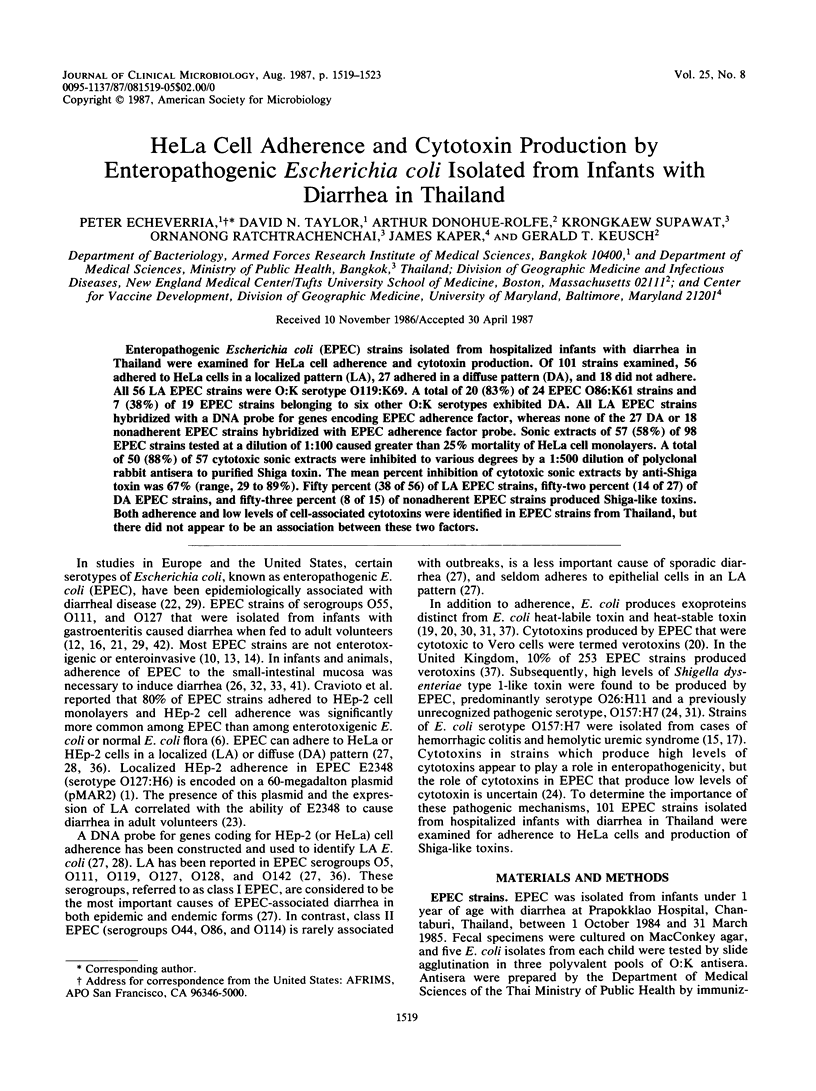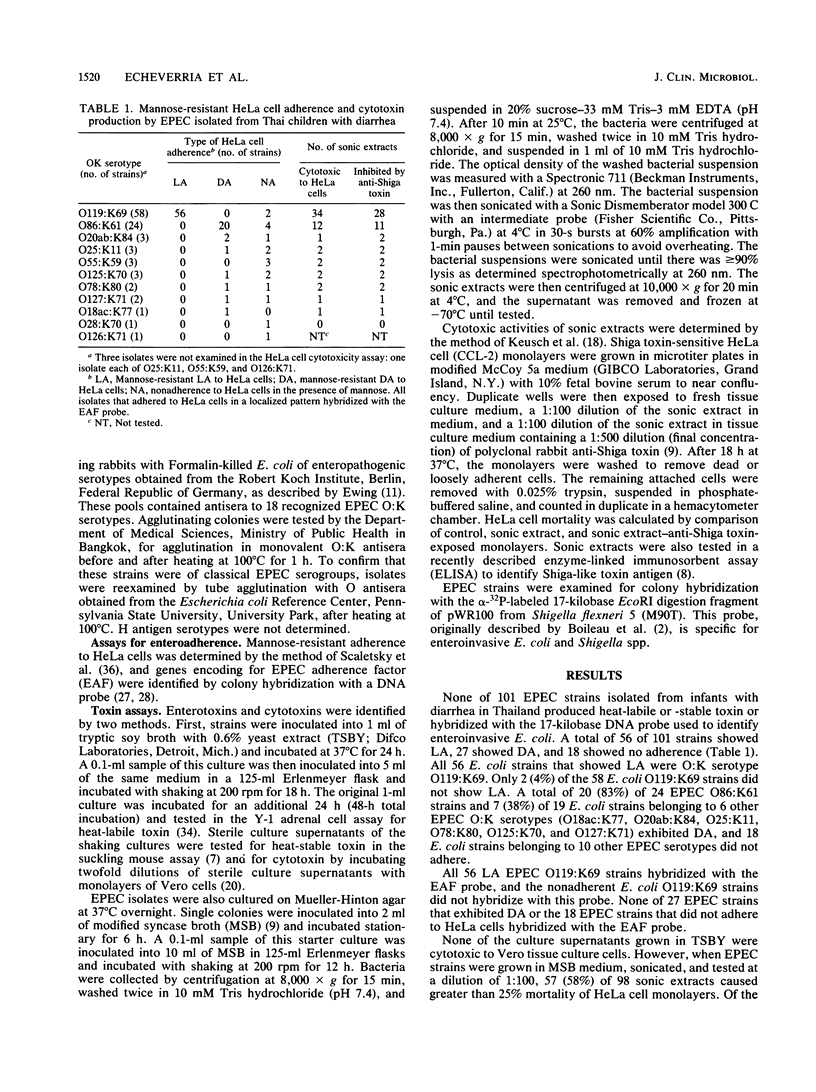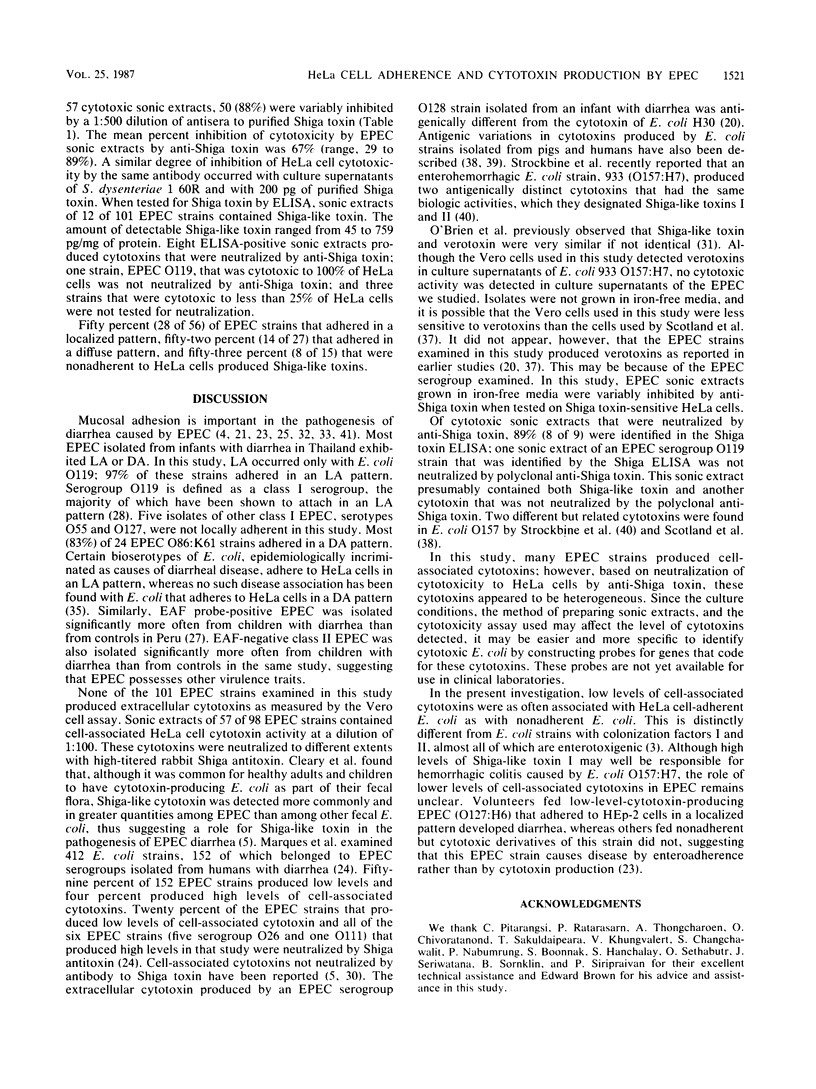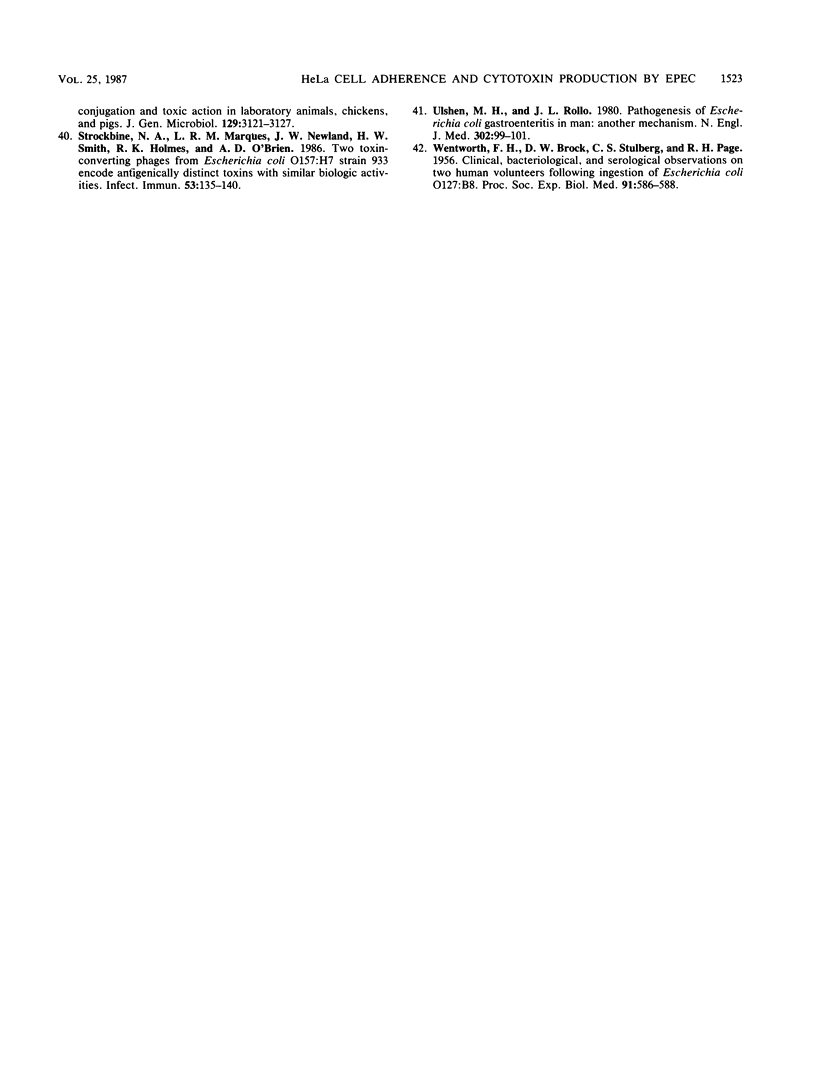Abstract
Enteropathogenic Escherichia coli (EPEC) strains isolated from hospitalized infants with diarrhea in Thailand were examined for HeLa cell adherence and cytotoxin production. Of 101 strains examined, 56 adhered to HeLa cells in a localized pattern (LA), 27 adhered in a diffuse pattern (DA), and 18 did not adhere. All 56 LA EPEC strains were O:K serotype O119:K69. A total of 20 (83%) of 24 EPEC O86:K61 strains and 7 (38%) of 19 EPEC strains belonging to six other O:K serotypes exhibited DA. All LA EPEC strains hybridized with a DNA probe for genes encoding EPEC adherence factor, whereas none of the 27 DA or 18 nonadherent EPEC strains hybridized with EPEC adherence factor probe. Sonic extracts of 57 (58%) of 98 EPEC strains tested at a dilution of 1:100 caused greater than 25% mortality of HeLa cell monolayers. A total of 50 (88%) of 57 cytotoxic sonic extracts were inhibited to various degrees by a 1:500 dilution of polyclonal rabbit antisera to purified Shiga toxin. The mean percent inhibition of cytotoxic sonic extracts by anti-Shiga toxin was 67% (range, 29 to 89%). Fifty percent (38 of 56) of LA EPEC strains, fifty-two percent (14 of 27) of DA EPEC strains, and fifty-three percent (8 of 15) of nonadherent EPEC strains produced Shiga-like toxins. Both adherence and low levels of cell-associated cytotoxins were identified in EPEC strains from Thailand, but there did not appear to be an association between these two factors.
Full text
PDF




Selected References
These references are in PubMed. This may not be the complete list of references from this article.
- Baldini M. M., Kaper J. B., Levine M. M., Candy D. C., Moon H. W. Plasmid-mediated adhesion in enteropathogenic Escherichia coli. J Pediatr Gastroenterol Nutr. 1983;2(3):534–538. doi: 10.1097/00005176-198302030-00023. [DOI] [PubMed] [Google Scholar]
- Boileau C. R., d'Hauteville H. M., Sansonetti P. J. DNA hybridization technique to detect Shigella species and enteroinvasive escherichia coli. J Clin Microbiol. 1984 Nov;20(5):959–961. doi: 10.1128/jcm.20.5.959-961.1984. [DOI] [PMC free article] [PubMed] [Google Scholar]
- Changchawalit S., Echeverria P., Taylor D. N., Leksomboon U., Tirapat C., Eampokalap B., Rowe B. Colonization factors associated with enterotoxigenic Escherichia coli isolated in Thailand. Infect Immun. 1984 Aug;45(2):525–527. doi: 10.1128/iai.45.2.525-527.1984. [DOI] [PMC free article] [PubMed] [Google Scholar]
- Clausen C. R., Christie D. L. Chronic diarrhea in infants caused by adherent enteropathogenic Escherichia coli. J Pediatr. 1982 Mar;100(3):358–361. doi: 10.1016/s0022-3476(82)80429-0. [DOI] [PubMed] [Google Scholar]
- Cleary T. G., Mathewson J. J., Faris E., Pickering L. K. Shiga-like cytotoxin production by enteropathogenic Escherichia coli serogroups. Infect Immun. 1985 Jan;47(1):335–337. doi: 10.1128/iai.47.1.335-337.1985. [DOI] [PMC free article] [PubMed] [Google Scholar]
- Dean A. G., Ching Y. C., Williams R. G., Harden L. B. Test for Escherichia coli enterotoxin using infant mice: application in a study of diarrhea in children in Honolulu. J Infect Dis. 1972 Apr;125(4):407–411. doi: 10.1093/infdis/125.4.407. [DOI] [PubMed] [Google Scholar]
- Donohue-Rolfe A., Kelley M. A., Bennish M., Keusch G. T. Enzyme-linked immunosorbent assay for shigella toxin. J Clin Microbiol. 1986 Jul;24(1):65–68. doi: 10.1128/jcm.24.1.65-68.1986. [DOI] [PMC free article] [PubMed] [Google Scholar]
- Donohue-Rolfe A., Keusch G. T., Edson C., Thorley-Lawson D., Jacewicz M. Pathogenesis of Shigella diarrhea. IX. Simplified high yield purification of Shigella toxin and characterization of subunit composition and function by the use of subunit-specific monoclonal and polyclonal antibodies. J Exp Med. 1984 Dec 1;160(6):1767–1781. doi: 10.1084/jem.160.6.1767. [DOI] [PMC free article] [PubMed] [Google Scholar]
- Echeverria P. D., Chang C. P., Smith D. Enterotoxigenicity and invasive capacity of "enteropathogenic" serotypes of Escherichia coli. J Pediatr. 1976 Jul;89(1):8–10. doi: 10.1016/s0022-3476(76)80917-1. [DOI] [PubMed] [Google Scholar]
- FERGUSON W. W., JUNE R. C. Experiments on feeding adult volunteers with Escherichia coli 111, B4, a coliform organism associated with infant diarrhea. Am J Hyg. 1952 Mar;55(2):155–169. doi: 10.1093/oxfordjournals.aje.a119510. [DOI] [PubMed] [Google Scholar]
- Goldschmidt M. C., DuPont H. L. Enteropathogenic Escherichia coli: lack of correlation of serotype with pathogenicity. J Infect Dis. 1976 Feb;133(2):153–156. doi: 10.1093/infdis/133.2.153. [DOI] [PubMed] [Google Scholar]
- Gross R. J., Scotland S. M., Rowe B. Enterotoxin testing of Escherichia coli causing epidemic infantile enteritis in the U.K. Lancet. 1976 Mar 20;1(7960):629–631. doi: 10.1016/s0140-6736(76)90429-3. [DOI] [PubMed] [Google Scholar]
- JUNE R. C., FERGUSON W. W., WORFEL M. T. Experiments in feeding adult volunteers with Escherichia coli 55, B5, a coliform organism associated with infant diarrhea. Am J Hyg. 1953 Mar;57(2):222–236. doi: 10.1093/oxfordjournals.aje.a119570. [DOI] [PubMed] [Google Scholar]
- Johnson W. M., Lior H., Bezanson G. S. Cytotoxic Escherichia coli O157:H7 associated with haemorrhagic colitis in Canada. Lancet. 1983 Jan 1;1(8314-5):76–76. doi: 10.1016/s0140-6736(83)91616-1. [DOI] [PubMed] [Google Scholar]
- KOYA G., KOSAKAI N., KONO M., MORI M., FUKASAWA Y. Observations on the multiplication of Escherichia coli 0-111 B4 in the intestinal tract of adult volunteers in feeding experiments, the intubation study with Miller-Abbott's double lumen tube. Jpn J Med Sci Biol. 1954 Apr;7(2):197–203. doi: 10.7883/yoken1952.7.197. [DOI] [PubMed] [Google Scholar]
- Karmali M. A., Petric M., Lim C., Fleming P. C., Arbus G. S., Lior H. The association between idiopathic hemolytic uremic syndrome and infection by verotoxin-producing Escherichia coli. J Infect Dis. 1985 May;151(5):775–782. doi: 10.1093/infdis/151.5.775. [DOI] [PubMed] [Google Scholar]
- Keusch G. T., Jacewicz M., Hirschman S. Z. Quantitative microassay in cell culture for enterotoxin of Shigella dysenteriae. J Infect Dis. 1972 May;125(5):539–541. doi: 10.1093/infdis/125.5.539. [DOI] [PubMed] [Google Scholar]
- Klipstein F. A., Rowe B., Engert R. F., Short H. B., Gross R. J. Enterotoxigenicity of enteropathogenic serotypes of Escherichia coli isolated from infants with epidemic diarrhea. Infect Immun. 1978 Jul;21(1):171–178. doi: 10.1128/iai.21.1.171-178.1978. [DOI] [PMC free article] [PubMed] [Google Scholar]
- Konowalchuk J., Speirs J. I., Stavric S. Vero response to a cytotoxin of Escherichia coli. Infect Immun. 1977 Dec;18(3):775–779. doi: 10.1128/iai.18.3.775-779.1977. [DOI] [PMC free article] [PubMed] [Google Scholar]
- Levine M. M., Edelman R. Enteropathogenic Escherichia coli of classic serotypes associated with infant diarrhea: epidemiology and pathogenesis. Epidemiol Rev. 1984;6:31–51. doi: 10.1093/oxfordjournals.epirev.a036274. [DOI] [PubMed] [Google Scholar]
- Levine M. M., Nataro J. P., Karch H., Baldini M. M., Kaper J. B., Black R. E., Clements M. L., O'Brien A. D. The diarrheal response of humans to some classic serotypes of enteropathogenic Escherichia coli is dependent on a plasmid encoding an enteroadhesiveness factor. J Infect Dis. 1985 Sep;152(3):550–559. doi: 10.1093/infdis/152.3.550. [DOI] [PubMed] [Google Scholar]
- Marques L. R., Moore M. A., Wells J. G., Wachsmuth I. K., O'Brien A. D. Production of Shiga-like toxin by Escherichia coli. J Infect Dis. 1986 Aug;154(2):338–341. doi: 10.1093/infdis/154.2.338. [DOI] [PubMed] [Google Scholar]
- McNeish A. S., Turner P., Fleming J., Evans N. Mucosal adherence of human enteropathogenic Escherichia coli. Lancet. 1975 Nov 15;2(7942):946–948. doi: 10.1016/s0140-6736(75)90360-8. [DOI] [PubMed] [Google Scholar]
- Moon H. W., Whipp S. C., Argenzio R. A., Levine M. M., Giannella R. A. Attaching and effacing activities of rabbit and human enteropathogenic Escherichia coli in pig and rabbit intestines. Infect Immun. 1983 Sep;41(3):1340–1351. doi: 10.1128/iai.41.3.1340-1351.1983. [DOI] [PMC free article] [PubMed] [Google Scholar]
- NETER E., SHUMWAY C. N. E. coli serotype D433: occurrence in intestinal and respiratory tracts, cultural characteristics, pathogenicity, sensitivity to antibiotics. Proc Soc Exp Biol Med. 1950 Nov;75(2):504–507. doi: 10.3181/00379727-75-18246. [DOI] [PubMed] [Google Scholar]
- Nataro J. P., Baldini M. M., Kaper J. B., Black R. E., Bravo N., Levine M. M. Detection of an adherence factor of enteropathogenic Escherichia coli with a DNA probe. J Infect Dis. 1985 Sep;152(3):560–565. doi: 10.1093/infdis/152.3.560. [DOI] [PubMed] [Google Scholar]
- Nataro J. P., Scaletsky I. C., Kaper J. B., Levine M. M., Trabulsi L. R. Plasmid-mediated factors conferring diffuse and localized adherence of enteropathogenic Escherichia coli. Infect Immun. 1985 May;48(2):378–383. doi: 10.1128/iai.48.2.378-383.1985. [DOI] [PMC free article] [PubMed] [Google Scholar]
- O'Brien A. D., LaVeck G. D., Thompson M. R., Formal S. B. Production of Shigella dysenteriae type 1-like cytotoxin by Escherichia coli. J Infect Dis. 1982 Dec;146(6):763–769. doi: 10.1093/infdis/146.6.763. [DOI] [PubMed] [Google Scholar]
- O'Brien A. O., Lively T. A., Chen M. E., Rothman S. W., Formal S. B. Escherichia coli O157:H7 strains associated with haemorrhagic colitis in the United States produce a Shigella dysenteriae 1 (SHIGA) like cytotoxin. Lancet. 1983 Mar 26;1(8326 Pt 1):702–702. doi: 10.1016/s0140-6736(83)91987-6. [DOI] [PubMed] [Google Scholar]
- Polotsky Y. E., Dragunskaya E. M., Seliverstova V. G., Avdeeva T. A., Chakhutinskaya M. G., Kétyi I., Vertényl A., Ralovich B., Emödy L., Málovics I. Pathogenic effect of enterotoxigenic Escherichia coli and Escherichia coli causing infantile diarrhoea. Acta Microbiol Acad Sci Hung. 1977;24(3):221–236. [PubMed] [Google Scholar]
- Rothbaum R., McAdams A. J., Giannella R., Partin J. C. A clinicopathologic study of enterocyte-adherent Escherichia coli: a cause of protracted diarrhea in infants. Gastroenterology. 1982 Aug;83(2):441–454. [PubMed] [Google Scholar]
- Sack D. A., Sack R. B. Test for enterotoxigenic Escherichia coli using Y-1 adrenal cells in miniculture. Infect Immun. 1975 Feb;11(2):334–336. doi: 10.1128/iai.11.2.334-336.1975. [DOI] [PMC free article] [PubMed] [Google Scholar]
- Scaletsky I. C., Silva M. L., Toledo M. R., Davis B. R., Blake P. A., Trabulsi L. R. Correlation between adherence to HeLa cells and serogroups, serotypes, and bioserotypes of Escherichia coli. Infect Immun. 1985 Sep;49(3):528–532. doi: 10.1128/iai.49.3.528-532.1985. [DOI] [PMC free article] [PubMed] [Google Scholar]
- Scaletsky I. C., Silva M. L., Trabulsi L. R. Distinctive patterns of adherence of enteropathogenic Escherichia coli to HeLa cells. Infect Immun. 1984 Aug;45(2):534–536. doi: 10.1128/iai.45.2.534-536.1984. [DOI] [PMC free article] [PubMed] [Google Scholar]
- Scotland S. M., Smith H. R., Rowe B. Two distinct toxins active on Vero cells from Escherichia coli O157. Lancet. 1985 Oct 19;2(8460):885–886. doi: 10.1016/s0140-6736(85)90146-1. [DOI] [PubMed] [Google Scholar]
- Smith H. W., Green P., Parsell Z. Vero cell toxins in Escherichia coli and related bacteria: transfer by phage and conjugation and toxic action in laboratory animals, chickens and pigs. J Gen Microbiol. 1983 Oct;129(10):3121–3137. doi: 10.1099/00221287-129-10-3121. [DOI] [PubMed] [Google Scholar]
- Strockbine N. A., Marques L. R., Newland J. W., Smith H. W., Holmes R. K., O'Brien A. D. Two toxin-converting phages from Escherichia coli O157:H7 strain 933 encode antigenically distinct toxins with similar biologic activities. Infect Immun. 1986 Jul;53(1):135–140. doi: 10.1128/iai.53.1.135-140.1986. [DOI] [PMC free article] [PubMed] [Google Scholar]
- Ulshen M. H., Rollo J. L. Pathogenesis of escherichia coli gastroenteritis in man--another mechanism. N Engl J Med. 1980 Jan 10;302(2):99–101. doi: 10.1056/NEJM198001103020207. [DOI] [PubMed] [Google Scholar]
- WENTWORTH F. H., BROCK D. W., STULBERG C. S., PAGE R. H. Clinical, bacteriological, and serological observations of two human volunteers following ingestion of Escherichia coli O127:B8. Proc Soc Exp Biol Med. 1956 Apr;91(4):586–588. doi: 10.3181/00379727-91-22338. [DOI] [PubMed] [Google Scholar]


